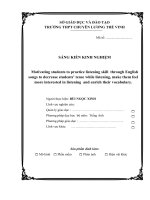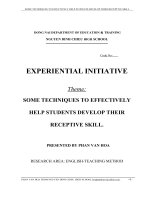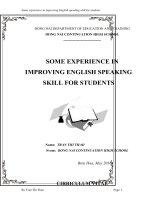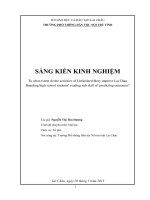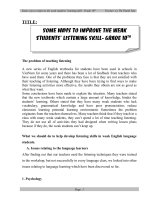skkn Motivating students to practice listening skill through English songs to decrease students’ tense while listening, make them feel more interested in listening and enrich their vocabulary
Bạn đang xem bản rút gọn của tài liệu. Xem và tải ngay bản đầy đủ của tài liệu tại đây (339.3 KB, 36 trang )
SỞ GIÁO DỤC VÀ ĐÀO TẠO
TRƯỜNG THPT CHUYÊN LƯƠNG THẾ VINH
Mã số: ................................
SÁNG KIẾN KINH NGHIỆM
Motivating students to practice listening skill through English
songs to decrease students’ tense while listening, make them feel
more interested in listening and enrich their vocabulary.
Người thực hiện: BÙI NGỌC XINH
Lĩnh vực nghiên cứu:
Quản lý giáo dục : …………………………………………
Phương pháp dạy học bộ môn: Tiếng Anh
Phương pháp giáo dục : …………………………………..
Lĩnh vực khác:
…………………………………..
Sản phẩm đính kèm:
Mô hình Phần mềm
Phim ảnh
Hiện vật khác
SƠ LƯỢC LÝ LỊCH KHOA HỌC
I. THÔNG TIN CHUNG VỀ CÁ NHÂN
1. Họ và tên: BÙI NGỌC XINH
2. Ngày tháng năm sinh: 21/07/1969
3. Giới tính: Nữ
4. Địa chỉ: 103/33 đường 30/4, phường Trung Dũng, Tp Biên Hòa, tỉnh Đồng
Nai.
5. Điện thoại: 0918.155005
6. E-mail:
7. Chức vụ: Giáo viên
8. Đơn vị công tác: Trường THPT Chuyên Lương Thế Vinh
II. TRÌNH ĐỘ ĐÀO TẠO
- Học vị (hoặc trình độ chuyên môn, nghiệp vụ) cao nhất: Thạc sĩ
- Năm nhận bằng: 2007
III. KINH NGHIỆM KHOA HỌC
- Số năm có kinh nghiệm: 20 năm
- Các sáng kiến kinh nghiệm đã có trong 5 năm gần đây:
1. How useful pre-reading activities are in teaching reading .
2. Helping gifted students enrich their idiomatic expressions.
3. The effectiveness of group work in teaching reading .
4. Extensive reading combined with extensive reading tasks to improve
students’ general knowledge , increase their engagement in class and enrich
their vocabulary.
SỞ GIÁO DỤC VÀ ĐÀO TẠO
TRƯỜNG THPT CHUYÊN
LƯƠNG THẾ VINH
CỘNG HOÀ XÃ HỘI CHỦ NGHĨA VIỆT NAM
Độc lập - Tự do - Hạnh phúc
Biên Hòa, ngày 03 tháng 5 năm 2012
PHIẾU NHẬN XÉT, ĐÁNH GIÁ SÁNG KIẾN KINH NGHIỆM
Năm học: 2011-2012
Tên sáng kiến kinh nghiệm: Motivating students to practice listening skill
through English songs to decrease students’ tense while listening, make them feel more
interested in listening and enrich their vocabulary.
Họ và tên tác giả: BÙI NGỌC XINH; Chức vụ: Giáo viên
Đơn vị: trường THPT Chuyên Lương Thế Vinh
Lĩnh vực: (Đánh dấu X vào các ô tương ứng, ghi rõ tên bộ môn hoặc lĩnh vực
khác)
- Quản lý giáo dục
- Phương pháp dạy học bộ môn: .............................
- Phương pháp giáo dục - Lĩnh vực khác: .....................................................
Sáng kiến kinh nghiệm đã được triển khai áp dụng: Tại đơn vị Trong Ngành
1. Tính mới (Đánh dấu X vào 1 trong 2 ô dưới đây)
- Có giải pháp hoàn toàn mới
- Có giải pháp cải tiến, đổi mới từ giải pháp đã có
2. Hiệu quả (Đánh dấu X vào 1 trong 4 ô dưới đây)
- Hoàn toàn mới và đã triển khai áp dụng trong toàn ngành có hiệu quả cao
- Có tính cải tiến hoặc đổi mới từ những giải pháp đã có và đã triển khai áp dụng
trong toàn ngành có hiệu quả cao
- Hoàn toàn mới và đã triển khai áp dụng tại đơn vị có hiệu quả cao
- Có tính cải tiến hoặc đổi mới từ những giải pháp đã có và đã triển khai áp dụng tại
đơn vị có hiệu quả
3. Khả năng áp dụng (Đánh dấu X vào 1 trong 3 ô mỗi dòng dưới đây)
- Cung cấp được các luận cứ khoa học cho việc hoạch định đường lối, chính sách:
Tốt
Khá
Đạt
- Đưa ra các giải pháp khuyến nghị có khả năng ứng dụng thực tiễn, dễ thực hiện và
dễ đi vào cuộc sống:
Tốt
Khá
Đạt
- Đã được áp dụng trong thực tế đạt hiệu quả hoặc có khả năng áp dụng đạt hiệu quả
trong phạm vi rộng:
Tốt
Khá
Đạt
XÁC NHẬN CỦA TỔ CHUYÊN MÔN
THỦ TRƯỞNG ĐƠN VỊ
(Ký tên và ghi rõ họ tên)
(Ký tên, ghi rõ họ tên và đóng dấu)
TABLE OF CONTENTS
- TITLE …………………………………………………………………… 2
- INTRODUCTION ……………………………………………………… 3
- RATIONALE OF THE STUDY…………………………………………3
- PROCEDURES……………………………………………………………7
- FINDINGS ………………………………………………………………..10
- CONCLUSION ………………………………………………………… 16
- APPENDIX 1……………………………………………………………...17
- APPENDIX 2…………………………………………………………… 26
-
REFERENCES ………………………………………………………… 31
Title
Motivating students to practice listening skill
through English songs to decrease students’ tense
while listening, make them feel more interested in
listening and enrich their vocabulary.
2
INTRODUCTION
Listening is one of the four main skills in learning English.
After many years of teaching at Luong The Vinh high school I have found that a lot of
students at this school are afraid of listening periods , seem very tense while listening in
class and almost have no pleasure in listening lessons because listening lessons which
are based on the school curriculum cannot provide them with what they want. However,
they very much want to improve their listening skill but they don’t know how to do it. As
a teacher, I think that I should do something to help them get pleasure from listening first
and then improve their listening skill . For this reason I would like to encourage the
students
to practice listening skill through songs in class and at home in order to decrease
tense while listening and enrich their vocabulary.
RATIONALE OF THE STUDY
a. What is Listening ?
“Listening” is different from “hearing” as Professor John Drakeford says
Hearing is a word used to describe the physiological sensory processes by which auditory sensations are
received by the ears and transmitted to the brain. Listening, on the other hand , refers to a more complex
psychological procedure involving interpreting and understanding the significance of the sensory experience.
( Drakeford , cited in Bolton 1987:32)
Listening skills allow one to make sense of and understand what another person is saying. In
other words, listening skills allow you to understand what someone is talking about.
3
“Listening without comprehension means that listening has not taken place successfully.” (
From the Course book : Teaching Listening & Speaking – SEAMEO – p 15 )
b. The importance of listening skill
Listening skill plays a very important role and we need good listening skills as Mckay points
out that “ Good listening skills make workers more productive. The ability to listen carefully
will allow you to :
-
better understand assignments and what is expected of you.
-
build rapport with other people
-
show support
-
work better in a team-based environment
-
answer questions ; and
-
find underlying meanings in what other say.”
Sarwar quotes a statement by Logan ( 1980 , in Sarwar , 2001 , pp 127-136 ) who says that “
People can learn from a variety of sources , even if the final goals are the same ” . Hence ,
teachers’ role is very crucial in leading students to developing their learning habits inside as
well as outside the classroom . One of the good learning habits is listening to English songs.
c. The aim of the innovation :
- To make listening lessons more interesting
- To decrease students’tense while listening
- To motivate students to practice listening to English songs at home
c. Why were songs chosen to teach ?
4
Lyn Newton points out that “singing songs and reading poems help expose students
to various types of genres” and he also shows us the benefits of listening to songs:
- Listening to songs is something people do in real life.
- The language in songs is authentic / real.
- They are interesting ; they motivate learners.
- Repetition is not boring if it is in a song.
- Rhythm and stress are easy in a song.
- New vocabulary is learnt in context.
- Listening to songs is a good group activity.
- We can all sing alone.
What’s more songs not only make students relaxed but also help them improve their
pronunciation , intonation and some grammar points.
d. How to choose songs
- The songs chosen must contain useful language ( words , vocabulary , idioms ,or
phrases that are usually used in daily life ) or grammar points that students need
to learn .
c. The participants of the study
45 students of class 12 A 1 of LTV high school were chosen to take part in the
innovation . The innovation was carried out in the last 7 minutes of listening periods after
the teacher and the students had already finished listening lessons. And the innovation lasted
10 weeks in the first semester ( from 10 October to 3 December,2010
5
The reason why the students of
class 12A 1 were chosen as the participants of the
study were that :
-
They like music .
-
They usually listen to music in their free time .
-
They all have a cassette player at home .
-
They usually listen to Vietnamese songs not English songs.
-
Some of them listen to English songs but they just listen to the music or tune of the
song not the lyrics.
( I once talked to them during speaking class about their free time ,and their attitude to
their listening skill .)
The Secondary Innovation
This innovation process could not be conducted without the secondary innovation
which was English songs . The researcher wanted to control the participants’participation
during the research process to see if they were interested in listening to songs , if they
really remembered any songs and if their vocabulary were enriched ( I think students will
remember vocabulary, phrases and sentences much easier, much longer if they listen to
them repeatedly ),so it was the researcher that introduced the English songs to the
research subjects . Here is a list of English songs used in the research ( See Appendix )
1. What Are You Doing ?
2. Who’s That Girl ?
6
3. Colors
4. Everybody Jump
5. Do-Re-Mi
6. Give Me Something Good to Eat
7. Today Is Monday
8. The Skeleton Dance
9. Don’t Let he Sun Go Down on Me
10. Heal the World
In addition, the students could find English songs on the Internet .
PROCEDURES.
1 ) Getting Started
a./ A questionnaire which consisted of 6 questions was used in order to find out what
the students thought about listening and what they had done to improve their listening
skill.
The questionnaire included both open-ended questions and questions with fixed
alternatives. For the questions with fix alternatives the students were asked to indicate
whether they “strongly agreed ” , “agreed ” , “were neutral ” ,
“disagreed ” or “strongly disagreed ” with each of the statements . For the open-ended
questions the students could freely express their thoughts about the extensive
7
reading activity and tasks .
The questionnaire revealed that
- 90 % of them thought that listening was the most difficult.
- 20 % reported that they often tried to listen to every word.
- 80 % of them felt that they were failed listeners when they could not understand the
listening lessons.
- 85 % of them felt very tense during listening periods.
- 90 % did not listen to English songs very often .
- 90 % of them reported that they could hardly learn any new vocabulary from the
listening lessons and if they learned any vocabulary they quickly forgot them.
- 95 % hardly knew any of the ten songs that the teacher gave them before the innovation.
b./ A pre-test on vocabulary
- A pre- test which consisted of 30 multiple-choice questions on vocabulary was used
. The giving of the pre- test to the students aimed at checking their vocabulary before the
innovation. After the students had finished the test the researcher asked the students to
hand in all of their tests and did not let them have a chance to look at the test again. The
purpose of doing this was that the researcher wanted to use the pre-test again as a posttest after the students had finished listening the ten songs to check if they learnt anything
from listening to songs.
( The vocabulary / idioms / phrasal verbs were taken from the songs that they were
8
going to listen to during the innovation.)
2 ) Students and teachers keep track of student progress by using English songs.
The listening of the songs could be carried out at the beginning of the listening periods as
warm-up or at the end of the listening periods.
Listening tasks
The purpose of giving listening tasks was “ to prompt students to keep listening. ” (
From the Course book : Teaching Listening and Speaking – SEAMEO – p 22 ) Hence , it
is advisable to encourage them to report back on their listening in a number of ways .
-
The teacher let the students listen to the song twice so that they could know the tune
or music of the song.
-
The teacher asked the students to talk about the song . ( e.g. What is the song about ?
Which vocabulary can you get from the song ? )
-
Then the teacher showed them the lyrics of the song and some new vocabulary of the
song.
-
The teacher let them listen to the song again and asked them sing along with the
record.
-
The teacher asked them to sing the song without listening to the record.
Oral reports
The students took turns or volunteered to sing the songs individually or in groups
9
Post -test ( Multiple -choice test on vocabulary )
The same multiple choice test on vocabulary / idioms / phrasal verbs was given a to the
students again to check if their vocabulary increased or if they gained any vocabulary
after they listened to the songs.
( The vocabulary / idioms / phrasal verbs were taken from the songs that they had
listened to.)
Questionnaire
A questionnaire was administered to the students at the end of the research . The
questionnaire was devised to find out (1 ) the students’motivation to songs ( 2 ) their
attitude towards listening ( 3 ) their evaluation on listening to songs ( 4 ) and their
comments on listening to songs .
The questionnaire included both open-ended questions and questions with fixed
alternatives .For the questions with fix alternatives the students were asked to indicate
whether they “strongly agreed ” , “agreed ” , “were neutral ” ,
“disagreed ” or “strongly disagreed ” with each of the statements . For the open-ended
questions the students could freely express their thoughts about the extensive reading
activity and tasks .
10
FINDINGS
a ) The Pre- test
The number of correct answers
The number of students who got the
correct answers
30
0(0%)
25
0(0%)
20
2 (4%)
15
3(6%)
10
15 ( 33 % )
5
23 ( 51 % )
0
2(4%)
The table showed that most of the students in class 12 A 1 seemed unfamiliar with some
vocabulary in the ten songs.
b ) The post test
The result of the post test :
11
The number of correct answers
The number of students who got the
correct answers
30
20 ( 44 % )
25
9 ( 20 % )
20
6 ( 13% )
15
5 ( 11 % )
10
5 ( 11% )
5
0(0%)
0
0 ( 0% )
The students did better on the post test than on the pre- test . This indicated that their
vocabulary was improved due to the listening activity .
12
c. ) Questionnaire
Questionnaire 1
What did you think about listening activity
?
A./
Statements
1
2
3
4
5
SA
A
N
D
SD
1. You think that listening is
very difficult .
2.You
feel
interested in
87 %
5%
4%
3%
6%
6%
10 %
75 %
6%
4%
10 %
80 %
9%
4%
6%
81 %
10
5%
listening .
3.You could learn a lot ( e.g.
vocabulary
, grammar points
)from listening lessons .
4. You listen to English songs
very often .
5. You feel tense in listening
periods.
85 %
%
6. You feel
relaxed
in
listening periods.
5%
14
70 %
11%
%
2./ Other comments
…………………………………………………………………………………………………………………………………………………………………………
…………………………………………………………………………..
13
Questionnaire 2
What did you think about listening to songs
?
A./
Statements
1
2
3
4
5
SA
A
N
D
SD
50%
35%
14%
60%
17%
14%
7%
80 %
10 %
5%
5
1. You thought that listening
was very difficult .
2. Listening to songs made you
feel more interested in listening
than before .
3.There were a lot of useful
vocabulary
in the songs you
listened to .
4.
%
You listened to English
71%
28
songs at home more often .
%
5. You felt less tense and more
relaxed in listening periods.
65 %
17%
9%
10
%
6. You started being interested
in listening to the lyrics of
53 %
17 %
14 %
English songs.
14
%
B. / Some comments given by the students when doing the questionnaire :
-
They could work at their own pace without classroom pressure .
-
They could listen for pleasure without the pressure of testing or marking .
-
Listening to songs made it possible for the weak students to participate in the
14
-
activity that they had never had during listening class before .
-
Songs brought them a lot of interesting vocabulary and they could remember the
vocabulary much more easily and longer.
Questionnaire findings revealed that
-
The students were engaged in the listening lessons.
-
The students felt more relaxed while listening to songs.
-
The students started being interested in English songs.
-
The students liked singing English songs , so they practiced listening to them more
often.
-
The relationship between the teacher and the students was better because they
sometimes discussed the content of a song , talked about the singers. Once they
invited the teacher to go singing karaoke with them.
-
They thought that listening activity was useful to them in many aspects : creating
confidence in learning English , encouraging them to become independent listeners ,
and helping them find pleasure and real purposes in listening
-
However , they also wished to be provided with authentic listening materials .
They wanted to be exposed to more real English world .
Summary
Listening to English songs really improved the students’vocabulary and they
felt motivated to listening . Listening tasks did increase the students’
15
engagement in class and they were eager to take part in these activities due to the fact
that they could work at their own pace without classroom pressure .
CONCLUSION
In an article by Littlewood ( 2000, p33 ) , there is a passage which says “ If
Asian students do indeed adopt the passive classroom attitudes that are often claimed ,
this is more likely to be a consequence of the educational contexts that have been or are
now provided for them than of any inherent dispositions of the students themselves ” .
Students cannot only adopt new ways of teaching from their teachers but also become
very responsible for their study and their tasks in class . They will become more
motivated if learning materials and teachers ‘way of teaching meet their expectations ,
needs , abilities and interests .
16
APPENDIX 1
Song 1
WHAT ARE YOU DOING ?
What are you doing ?
I’m playing a game. Watch what I do, and then do the same.
What are you doing ? I’m playing a game. Watch what I do, and then do the same.
Nod your head.
Cover your ears.
Bend your knees.
Count to four.
Stamp your feet.
Cross your legs
Now say “please”
Touch the floor.
Clap your hands.
Touch the floor.
Count to three.
Blink your eyes.
Wiggle your toes.
Open your mouth.
Smile at me.
Shout “surprise!”
Snap your fingers.
Stretch your neck.
Climb a tree.
Brush your hair.
Raise your arms.
Straighten your shoulders.
Wave at me.
Sit on your chair.
( Repeat chorus )
( Repeat chorus )
17
Song 2
WHO’S THAT GIRL ?
Who’s that ?
Who’s that ?
Who’s that girl ? Who’s that ?
Who’s that girl in the short black dress ?
That’s my older sister , Bess.
Who’s that ?
Who’s that ?
Who’s that boy ? Who’s that ?
Who’s that boy with the baseball bat ?
That’s my younger brother , Pat .
Who’s that woman in the long red skirt ?
Who’s that man in the bright green shirt ?
Who’s that boy with the curly hair ?
Who’s that girl with the teddy bear ?
That’s my mother in the long red skirt.
That’s my father in the bright green skirt.
That’s my brother with the curly hair.
That’s my sister with teddy bear.
18
Song 3
COLOURS
Red , Yellow , Blue and Green stand up.
Red , Yellow , Blue and Green turn around, and stretch up high above your head
Red , Yellow , Blue and Green sit down.
Pink , Purple , Brown and Tan stand up.
Pink , Purple , Brown and Tan turn around , stretch up high above your head
Pink , Purple , Brown and Tan sit down.
Gold , Silver ,Black and White stand up.
Gold , Silver ,Black and White turn around, and stretch up high above your head
Gold , Silver ,Black and White sit down.
Song 4
EVERYBODY JUMP
Jump , jump , jump everybody jump
We play football in the play ground
You play see-saw in the play ground
We have fun and joy. Everybody jump.
Climb, climb, climb everybody climb
We play football in the play ground
You play see-saw in the play ground
We have fun and joy. Everybody climb.
Swing , swing , swing everybody swing
We play football in the play ground
You play see-saw in the play ground
19
We have fun and joy. Everybody swing.
Clap, clap ,clap everybody clap
We play football in the play ground
You play see-saw in the play ground
We have fun and joy. Everybody clap.
Song 5
DO-RE-MI
Doe, a deer , a female deer
Ray , a drop of golden sun
Me , a name I call myself
Far , a long long way to run
Sew, a needle pulling thread
La , a note to follow sew
Tea, I drink with jam a bread
That would bring us back to doe. . .oh oh oh
Do re mi fa so la ti do, so do
Song 6
GIVE ME SOMETHING GOOD TO EAT
Trick or treat ?
Trick or treat ?
Give me something good to eat
Apples , peaches , tangerines.
Happy Happy Halloween
Trick or treat ?
Trick or treat ?
Give me something sweet to eat.
20
Cookies , chocolate , jelly beans.
Happy Happy Halloween .
Trick or treat ?
Trick or treat ?
Give me something sour to eat.
Lemons , grapefruits, limes so green.
Happy Happy Halloween .
Trick or treat ?
Trick o treat ?
Give me something good to eat.
Nuts and candy. Lollipops.
Now it’s time for us to stop.
Song 7
TODAY IS MONDAY
Today is Monday is Monday, Monday washday. Are you hungry brothers ? We wish the same
to you.
Today is Tuesday , today is Tuesday,
Tuesday string beans , Monday washday. Are you hungry brothers ? We wish the same to
you.
Today is Wednesday, today is Wednesday , Wednesday soup , Tuesday string beans, Monday
washday . Are you hungry brothers ? We wish the same to you.
Today is Thursday , today is Thursday. Thursday roast beef .Wednesday soup . Tuesday
string beans, Monday washday . Are you hungry brothers ? We wish the same to you.
Today is Friday , today is Friday ,
Friday fish , Thursday roast beef ,Wednesday soup, Tuesday string beans, Monday
21
washday . Are you hungry brothers ? We wish the same to you.
Today is Saturday , today is Saturday,
Saturday payday, Friday fish , Thursday roast beef ,Wednesday soup, Tuesday string beans,
Monday washday . Are you hungry brothers ? We wish the same to you.
Today is Sunday , today is Sunday ,
Sunday church, Saturday payday, Friday fish , Thursday roast beef ,Wednesday soup,
Tuesday string beans, Monday washday . Are you hungry brothers ? We wish the same to
you.
Song 8
THE SKELETON DANCE
The thigh bone’s connected to the hip bone.
The hip bone’s connected to the backbone.
The backbone’s connected to the neck bone.
Doin’the skeleton dance.
Shake your hands to the left.
Shake your hands to the right.
Put your hands in the air.
Put your hands out of sight!
Shake your hands to the left.
Shake your hands to the right.
Put your hands in the air.
Wiggle , wiggle , wiggle, wiggle
wiggle , wiggle , wiggle, wiggle ,
wiggle , wiggle, wiggle , wiggle . . .
22


